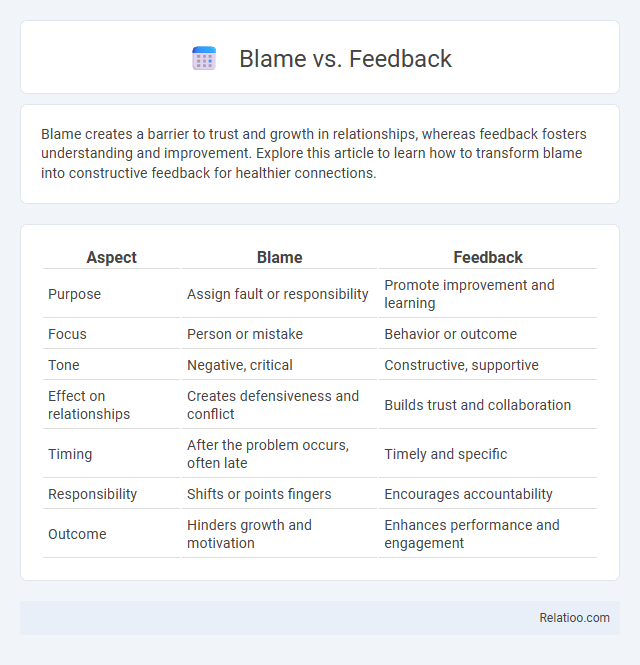Blame creates a barrier to trust and growth in relationships, whereas feedback fosters understanding and improvement. Explore this article to learn how to transform blame into constructive feedback for healthier connections.
Table of Comparison
| Aspect | Blame | Feedback |
|---|---|---|
| Purpose | Assign fault or responsibility | Promote improvement and learning |
| Focus | Person or mistake | Behavior or outcome |
| Tone | Negative, critical | Constructive, supportive |
| Effect on relationships | Creates defensiveness and conflict | Builds trust and collaboration |
| Timing | After the problem occurs, often late | Timely and specific |
| Responsibility | Shifts or points fingers | Encourages accountability |
| Outcome | Hinders growth and motivation | Enhances performance and engagement |
Understanding the Concepts: Blame vs Feedback
Understanding the concepts of blame versus feedback is crucial for fostering a constructive work environment. Blame assigns fault and often leads to defensiveness, while feedback focuses on helping you improve by providing specific, actionable insights. Emphasizing feedback over blame enhances communication, promotes learning, and drives better performance outcomes.
The Psychological Impact of Blame
Blame often triggers defensive responses, increasing stress and reducing motivation, which negatively impacts mental well-being and team dynamics. Unlike feedback, which fosters growth by focusing on behaviors and solutions, blame centers on fault and personal shortcomings, leading to fear and decreased trust. Understanding the psychological impact of blame is essential for creating healthier, more productive environments that promote learning and collaboration.
Feedback: A Tool for Growth and Improvement
Feedback serves as a powerful tool for growth and improvement by providing specific, constructive insights that help you identify strengths and areas for development. Unlike blame, which focuses on assigning fault, feedback fosters a supportive environment where learning and progress are prioritized. Effective feedback encourages reflection, promotes accountability, and drives continuous personal and professional advancement.
Key Differences Between Blame and Feedback
Blame focuses on assigning fault and often creates a defensive atmosphere, hindering open communication and problem-solving. Feedback, on the other hand, provides constructive insights aimed at improvement and growth without targeting personal failure. Understanding these key differences helps you foster a positive environment where learning and development thrive.
How Blame Undermines Team Performance
Blame creates a toxic work environment that erodes trust and stifles open communication, leading to decreased collaboration and innovation. Teams focused on blame are less likely to learn from mistakes, resulting in repeated errors and stagnant growth. Constructive feedback fosters accountability and continuous improvement, while blame shifts responsibility away from problem-solving, ultimately undermining overall team performance.
Building a Culture of Constructive Feedback
Blame creates a hostile environment that stifles growth, whereas feedback fosters developmental dialogue essential for continuous improvement within teams. Constructive feedback emphasizes specific behaviors and actionable suggestions, encouraging accountability without inducing fear or defensiveness. Prioritizing a culture of feedback over blame enhances psychological safety, driving higher engagement, innovation, and performance.
Common Triggers for Blame in the Workplace
Common triggers for blame in the workplace include unclear communication, unmet expectations, and lack of accountability. These factors often create a stressful environment where employees feel defensive and assign fault rather than focusing on constructive solutions. Addressing these triggers through transparent dialogue and defined responsibilities fosters a culture of growth and effective feedback.
Strategies to Replace Blame with Feedback
Replacing blame with feedback requires fostering a culture of psychological safety where individuals feel secure to discuss mistakes constructively. Implementing clear communication strategies focused on behavior and outcomes rather than personal faults encourages accountability and continuous improvement. Training leaders to model empathy and ask open-ended questions enhances problem-solving and shifts the focus from judgment to learning.
The Role of Leadership in Shaping Feedback Practices
Effective leadership cultivates a culture where feedback is perceived as a tool for growth rather than blame. Leaders who prioritize transparent communication and active listening foster environments that encourage constructive feedback, enhancing team performance and innovation. By modeling accountability and empathy, leadership shapes feedback practices that promote psychological safety and continuous improvement.
Measuring the Benefits of Feedback Over Blame
Measuring the benefits of feedback over blame involves analyzing how constructive criticism impacts employee performance, motivation, and workplace culture compared to the negative effects of blame, which often leads to decreased morale and productivity. Studies show that feedback fosters a growth mindset, increases engagement, and reduces errors by encouraging learning from mistakes, whereas blame triggers fear and defensiveness. By prioritizing feedback in your management approach, you can enhance team collaboration and drive continuous improvement more effectively than relying on blame.

Infographic: Blame vs Feedback
 relatioo.com
relatioo.com